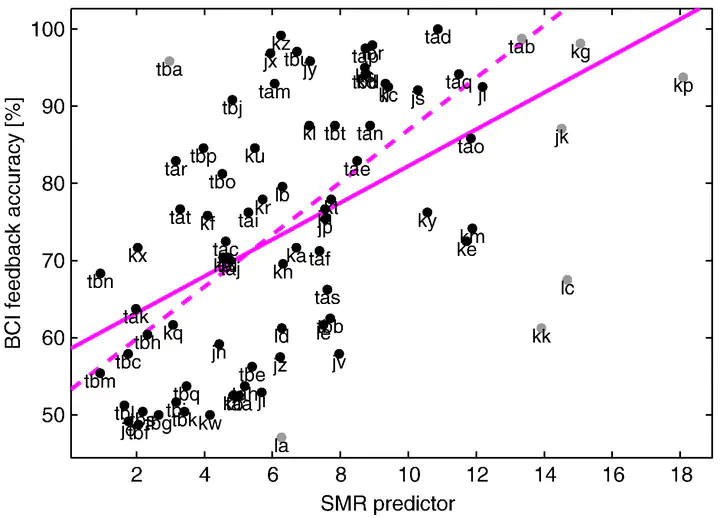Performance prediction of c-VEP BCI

Context
A brain-computer interface (BCI) harnesses an extensive range of control signals decoded from measured electroencephalogram (EEG) data. Among the fastest BCIs for communication and control applications is the utilization of the code-modulated visual evoked potential (c-VEP). This signal is triggered by a pseudo-random sequence of flashes. While a c-VEP BCI exhibits remarkable accuracy, enabling nearly all users to achieve 90-100 percent accuracy and eliminating BCI-illiteracy, there remains a notable variance in the speed achieved by different users.
These disparities may be indicative for instance of varied neural responses, scalp anatomy, or mental states among users. The objective of this project is twofold: (1) to identify predictors for c-VEP BCI performance, delving into the underlying (neural) mechanisms, and (2) potentially discovering ways to enhance aspects of the BCI. The ultimate goal is to ensure that all users can attain high-performance levels, advancing our understanding of c-VEP BCI performance and paving the way for improved inclusivity and efficiency.
Image credit: Blankertz, B., Sannelli, C., Halder, S., Hammer, E. M., Kübler, A., Müller, K. R., … & Dickhaus, T. (2010). Neurophysiological predictor of SMR-based BCI performance. NeuroImage, 51(4), 1303-1309.
Research question
This project aims to explore the factors contributing to the variability observed in c-VEP BCI performance. Various factors of interest will be examined, such as heart rate and heart rate variability, fixation stability, pupil size, alpha activity, VEP latency variability, and other neural spontaneous oscillations during both resting tasks and BCI usage. Additionally, the project could assess several bahvioural aspects, such as the general attention span, as measured by additional tasks or questionaires and other pertinent indicators.
The methodology involves a comprehensive investigation of these relevant features, with the ultimate goal of developing a robust algorithm that predicts BCI performance. This algorithm will leverage the identified features to predict c-VEP BCI performance, shedding light on the intricate interplay of physiological and cognitive factors influencing the effectiveness of the BCI system. Additionally, this algorithm may highlight factors that might be investigated for a user that is underperforming, allowing training oportunities to reach high performances for all users.
Furthermore, this project has the potential to pinpoint factors that warrant investigation in cases of underperformance by users. This identification of key factors could pave the way for targeted training opportunities, aiming to elevate the performance of all users to higher levels of proficiency, promoting inclusivity and efficiency.
Skills / background required
- Very proficient in Python
- Proficient in machine learning
- Knowledge/interst in vision neuroscience